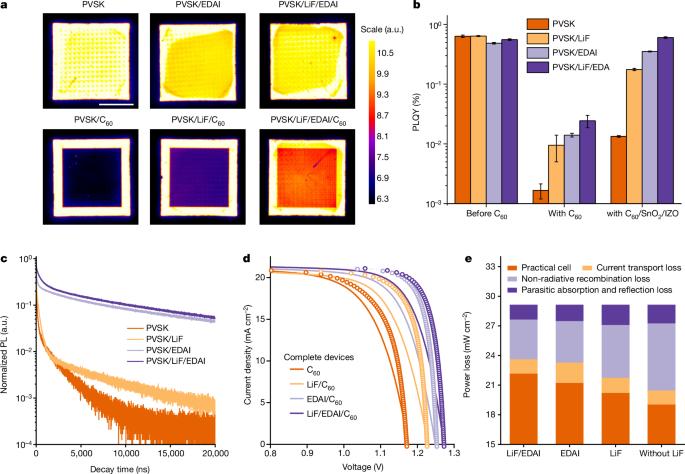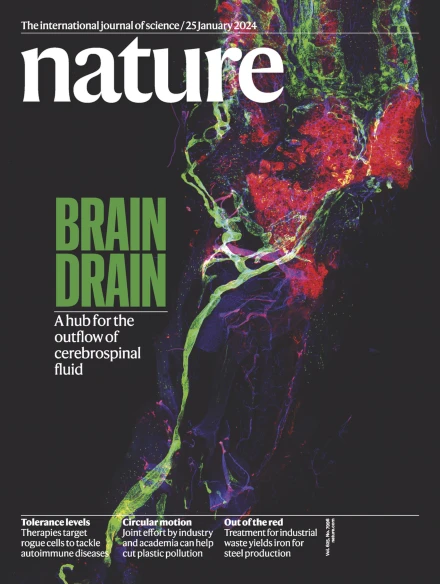具有双层界面钝化的过氧化物硅串联太阳能电池。
IF 48.5
1区 综合性期刊
Q1 MULTIDISCIPLINARY SCIENCES
引用次数: 0
摘要
与单结太阳能电池相比,双端单片包晶体-硅串联太阳能电池在功率转换效率(PCE)方面具有巨大优势1,2。然而,如何在不影响其卓越电荷传输性能的前提下抑制宽带隙包晶石/电子传输层界面的界面重组,仍然是包晶石-硅串联电池面临的重大挑战3,4。通过利用纳米级离散分布的 LiF 超薄层,再额外沉积二碘化二铵盐分子,我们设计出了一种双层交织钝化策略,既能高效提取电子,又能进一步抑制非辐射重组。我们在双面纹理的 Czochralski(CZ)基硅异质结电池上构建了过氧化物硅烷串联器件,其特点是前表面纹理轻微,后表面纹理严重,从而同时增强了光电流和无损后钝化。经独立认证,这种珍珠光泽石-硅串联电池的稳定 PCE 为 33.89%,填充因子 (FF) 为 83.0%,开路电压 (Voc) 接近 1.97 伏。据我们所知,这是首次有报告称双结串联太阳能电池的认证效率超过了单结肖克利-奎塞尔(Shockley-Queisser)33.7% 的限制。本文章由计算机程序翻译,如有差异,请以英文原文为准。

Perovskite/silicon tandem solar cells with bilayer interface passivation
Two-terminal monolithic perovskite/silicon tandem solar cells demonstrate huge advantages in power conversion efficiency compared with their respective single-junction counterparts1,2. However, suppressing interfacial recombination at the wide-bandgap perovskite/electron transport layer interface, without compromising its superior charge transport performance, remains a substantial challenge for perovskite/silicon tandem cells3,4. By exploiting the nanoscale discretely distributed lithium fluoride ultrathin layer followed by an additional deposition of diammonium diiodide molecule, we have devised a bilayer-intertwined passivation strategy that combines efficient electron extraction with further suppression of non-radiative recombination. We constructed perovskite/silicon tandem devices on a double-textured Czochralski-based silicon heterojunction cell, which featured a mildly textured front surface and a heavily textured rear surface, leading to simultaneously enhanced photocurrent and uncompromised rear passivation. The resulting perovskite/silicon tandem achieved an independently certified stabilized power conversion efficiency of 33.89%, accompanied by an impressive fill factor of 83.0% and an open-circuit voltage of nearly 1.97 V. To the best of our knowledge, this represents the first reported certified efficiency of a two-junction tandem solar cell exceeding the single-junction Shockley–Queisser limit of 33.7%. A power conversion efficiency of 33.89% is achieved in perovskite/silicon tandem solar cells by using a bilayer passivation strategy to enhance electron extraction and suppress recombination.
求助全文
通过发布文献求助,成功后即可免费获取论文全文。
去求助
来源期刊

Nature
综合性期刊-综合性期刊
CiteScore
90.00
自引率
1.20%
发文量
3652
审稿时长
3 months
期刊介绍:
Nature is a prestigious international journal that publishes peer-reviewed research in various scientific and technological fields. The selection of articles is based on criteria such as originality, importance, interdisciplinary relevance, timeliness, accessibility, elegance, and surprising conclusions. In addition to showcasing significant scientific advances, Nature delivers rapid, authoritative, insightful news, and interpretation of current and upcoming trends impacting science, scientists, and the broader public. The journal serves a dual purpose: firstly, to promptly share noteworthy scientific advances and foster discussions among scientists, and secondly, to ensure the swift dissemination of scientific results globally, emphasizing their significance for knowledge, culture, and daily life.
 求助内容:
求助内容: 应助结果提醒方式:
应助结果提醒方式:


